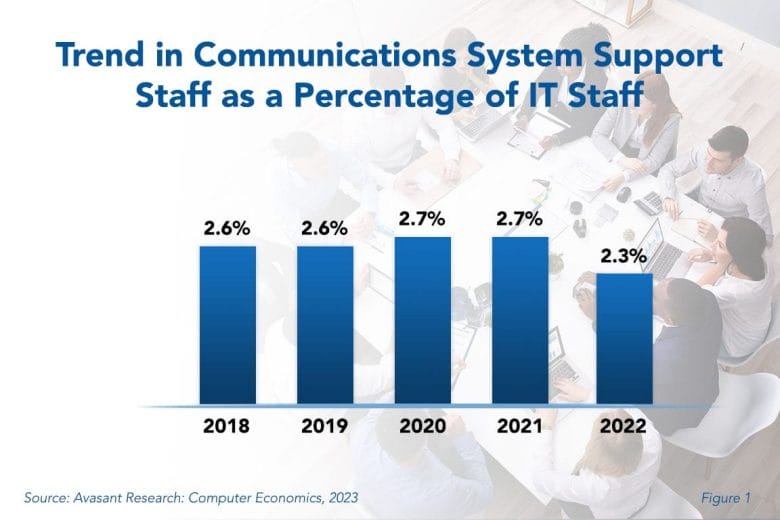Hybrid work is pushing corporate communications systems and the staff that supports them. As cloud-based communications solutions emerge and AI reshapes communications support, a wave of complexity engulfs us. Yet, despite the growing complexity, the number of IT specialists who support communications systems was stable in the past few years.
In 2022, the size of the communications system support staff as a percentage of the IT staff fell at the median, as shown in Figure 1 from our full report, Communications Support Staffing Ratios. It is possible that this is a sign of cuts to communications support staffing, but it is more likely due to increases in other areas of staffing, especially in project management, data analytics, and security. In other words, it is not that organizations require fewer communications support staff. Rather, they have been able to hold support staff steady while other job functions have been increasing.

As collaboration tools continue to evolve and become more intricate, there is a growing demand for expanded communications options. This demand is expected to match or even surpass the efficiency gains driven by automation, AI, and cloud computing. Organizations have honed their ability to utilize digital platforms effectively and leverage data for tracking communications effectiveness. As a result, corporate communications systems have become more flexible, impactful, and efficient in meeting evolving needs.
“Embracing the complexities of hybrid work, organizations must navigate the evolving landscape of corporate communications,” said Asif Cassim, principal research analyst for Computer Economics, a service of Avasant Research, based in Los Angeles. “It is remarkable that, despite this complexity, organizations have been able to manage this critical function without adding to communications support staffing.”
Remaining vigilant and adapting to evolving communication technology trends is crucial for organizations, including right-sizing their communications support staff. The adoption of AI-driven and cloud-based communications tools offers a glimmer of relief. Embracing these advancements can lead to improved effectiveness and streamlined operations in corporate communications.
The personnel who comprise the communications system support staff include engineers, analysts, specialists, and administrators who manage email, texts, telephony, videoconferencing, unified communications, and other communications systems. We place this support staff within a broader classification of the Network and Communications Group.
The full report helps IT managers determine whether their organization is keeping pace with changes in communications systems by comparing their support staff against industry benchmarks. The study uses three metrics to make that assessment: communications system support staff as a percentage of the IT staff; percentage of support staff in relation to organization size; and communications support staff spending per user. We provide benchmarks for the composite sample and by organization size and sector. We also provide a benchmark for the larger network and communications group, which includes personnel engaged in supporting network and web infrastructure and security personnel. We conclude with recommendations for optimizing the productivity of communications system support personnel.
This Research Byte is a brief overview of our management advisory on this subject, Communications Support Staffing Ratios. The full report is available at no charge for Computer Economics clients, or it may be purchased by non-clients directly from our website (click for pricing).

